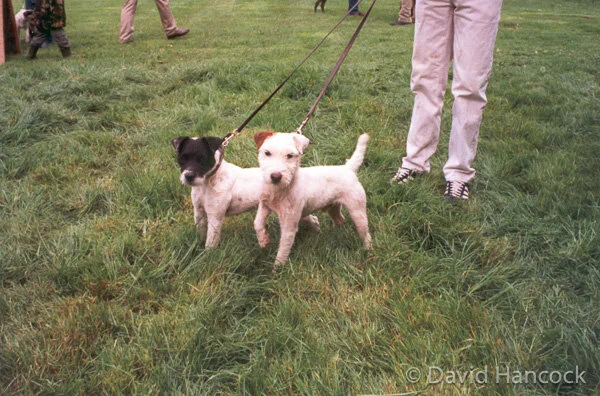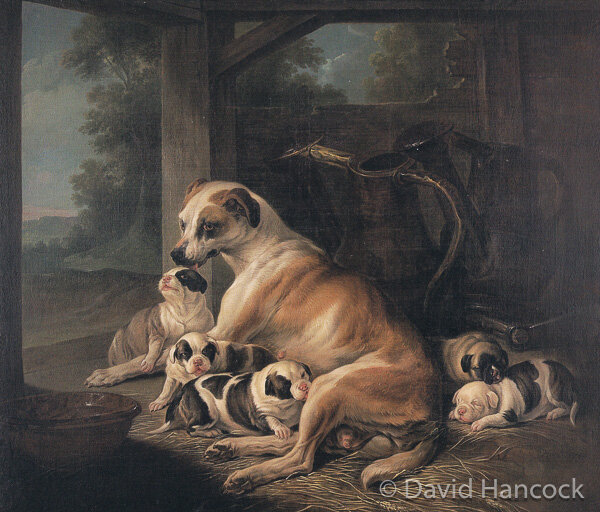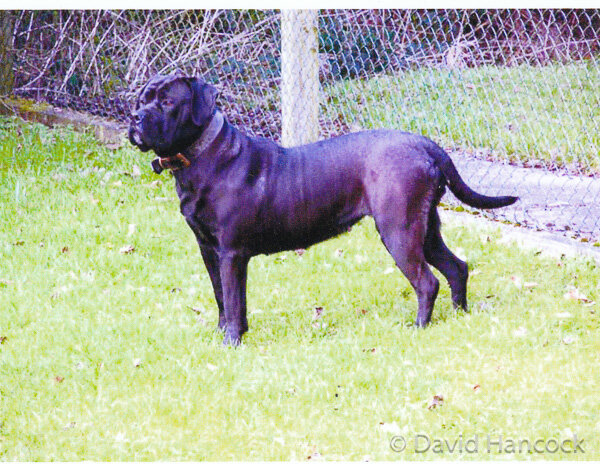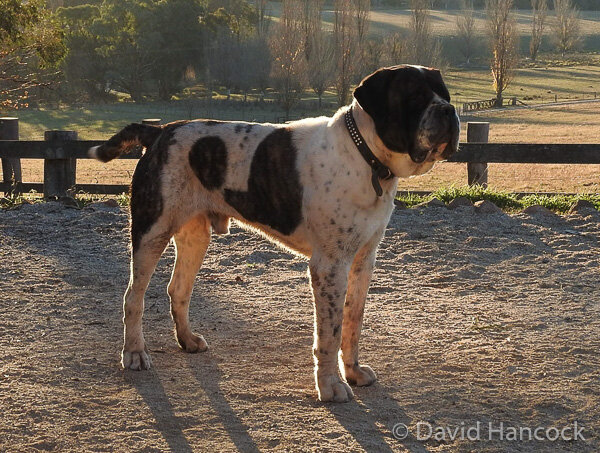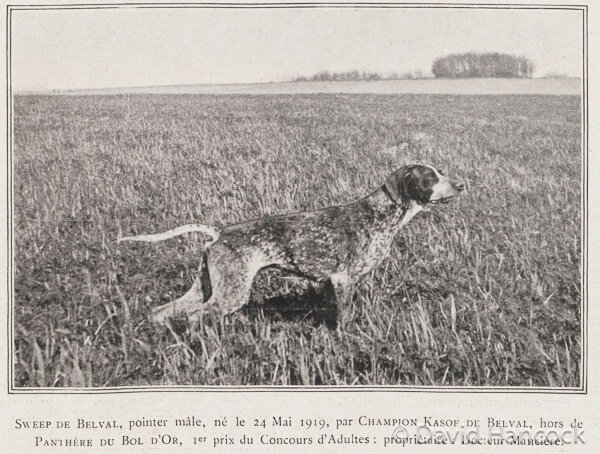1093
NO BAD COLOUR FOR A DOG
By David Hancock
An old saying goes 'there's no bad colour for a dog', but colour prejudice in pedigree breeds of dog is commonplace. Yet genetic diversity is at last being hailed as important and the loss of a colour from a breed's gene pool a needless loss of diversity. The worn-out observation that, when an unpermitted or undesired colour crops up in a litter then a rogue sire has crept into the kennel unnoticed, is just lazy. But I still hear it alleged, usually out of earshot, whenever a surprising coat-colour is found in a litter. Breeders of domestic animals don't welcome surprises in their litters; tease your nearest cat-breeder about the inheritance of tortoise-shell in cats and then ask why they are always female! The celebrated vet, and writer of the 1900s, Frank Townend Barton, once bred a white pup from purebred Bloodhounds, perhaps a throwback to the Talbot Hound, but consigned it to the bucket fearing a misalliance, to his subsequent regret. An all-black GSD would not win in today's show rings, whatever its merits. A merle GSD has not appeared, or been admitted to, for half a century, despite the known gene pool's contents. And, when did you last see a white Lakeland Terrier, often favoured by the working terrier men but not acceptable in the show ring. A black Samoyed would surprise many but the colour is very much in the breed's gene pool.
White-coated dogs are paradoxically both preferred and discriminated against in the world of the show-dog, with glamorous breeds like the Samoyed and the Maremma Sheepdog being prized because of their magnificent white coats whereas a white coat in breeds like the Boxer and the German Shepherd Dog is not desired. The nearly all-white Rough Collie is favoured in America but not here. I see many mainly white working sheepdogs but I doubt if a show ring Border Collie would get far in this hue. Breeders of Kyi-Leos, Canaan dogs, Akitas, Pomeranians, Chow-chows, Pekingese and Polish Lowland Sheepdogs often have strong views on white coats in their breed. White is the natural colour for Pomeranians; the original bigger white variety, rather like the Japanese Spitz and Volpino of today, was a most beautiful dog -- now lost to us through human whim. Colour-prejudice in pedigree dogs is widespread yet admits to no rhyme or reason, with the parallel desire and distaste for all-white shepherd dogs aptly illustrating this conflict.
For a fancier to opt for a colour other than white in his preferred breed is an exercise in personal choice. But for an approved breed standard to exclude or frown on white as a colour is somewhat dictatorial and can so easily consign an otherwise excellent white pup to oblivion. Where is the logic in white being encouraged in the Maremma, Kuvasz, Komondor, Pyrenean mountain dog, Owtcharkas, Schafpudel and Algerian sheepdog but discouraged in some other pastoral breeds? Again and again, you can read the tired old theories about the white dog merging better with the sheep or the shepherd being able to see the white dog better at night or sheep not being able to tell a non-white dog from a wolf. Such theorists conveniently overlook the fact that most sheep are not white and that most flock-guarding breeds are not white either, like the Caucasian, the Anatolian, the Karst, the Croatian, the Fonni, the Estrela mountain dog, the Tibetan Mastiff, the Vikhan, the Powinder, the Bhotia, the Bangara, the Bisben, the Cao Rafeiro do Alentejo and the Appenzeller mountain dog, some of whom are actually wolf-colour. The breed standards reveal the irrational prejudice.
In the Bearded Collie, white should not appear above the hocks on the outside of the hind-legs. In the Border Collie, white should never predominate. In the Bouvier des Flandres white predominating is highly undesirable. In the Rough and Smooth Collies mainly or wholly white is not recognised. In the Estrela Mountain Dog white markings are tolerated but are considered undesirable. In the German Shepherd Dog whites or even near-whites are highly undesirable. In the Old English Sheepdog, white patches in the main colour are discouraged. In the Shetland Sheepdog patches of white on the body are regarded as highly undesirable. In the Cardigan Corgi, white should not predominate.
In each of these breeds, quite rightly, the working origin is revered by the breed-devotees. Yet in the pastures, shepherds have never discriminated against a good working dog on the grounds that it was the wrong colour. There are many mainly white working sheepdogs but I have seen none in Border Collie classes at conformation dog shows. Once again, the armchair experts home in, e.g., the Border Collie is a "strong-eyed" dog and the strong-eye has a much greater effect on the sheep it is trying to control if it is set in black rather than white. Why then did such outstandingly strong-eyed but white-headed dogs as Wilson's Cap (the founder of all modern working dogs), Tim Longton's Roy, Squires's Jaff, McTeir's Ben, the Scottish champion Spot and British Supreme champion in 1975 and 1979, Zac, reign supreme? Are we breeding for the best or solely for colour-favouritism?
One of the best security dogs in the Armed Forces in recent years was a white German Shepherd Dog. Captain von Stephanitz, a pillar in the development of the breed, once wrote:..."our German sheepdogs have never been bred for colour, the latter being of complete indifference in a working dog." I haven't seen that written in more recent times. I can understand the very sensible wish to avoid breeding albinos and to retain good pigmentation but find it hard to justify penalising a really good dog because of the colour of its coat. The Pomeranian Sheepdog, now lost to us, was a pure-white German sheepdog. The dog acknowledged as the foundation dog of contemporary German Shepherd Dog bloodlines, Horand von Grafrath, born in 1895, had a white grandsire. But after the death of von Stephanitz, white dogs were discriminated against, leading to their disqualification in Germany and then in America in 1968 from conformation shows. One was however the top obedience German Shepherd in America in 1968. In 1978, a white dog was the top dog in the US police canine association and a white Canadian GSD police-dog has been credited with over 200 arrests and rated highly. I can find nothing but admiration for the white GSDs in the Hoof Print kennel of Joanne Chanyi in Ontario; why should such admirable dogs not be accepted on merit?
I suspect that human whim rather than human wisdom is behind this prejudice, perhaps rooted in fears of colour-dilution when white genes are present. All-white or no-white seems to be the rule, all-white usually only being acceptable when exclusivity is the basic criterion. Such prejudice or preference affects primitive as well as sophisticated people; the Balinese Mountain Dog is a purely white Akita-like dog, the Samoyed people favoured all-white dogs, unlike their neighbours in Kamchatka who preferred black and white dogs. An early owner of Samoyed dogs in this country, the Hon. Mrs. MacLaren Morrison, showed a black Samoyed, which won at Cheltenham in 1905; could this happen today? White GSDs may be scorned despite their merits, but black ones too are rarely favoured, whatever theirs.
The Akbash and Karabash lobbies within the Anatolian Shepherd Dog fanciers continue to dispute the true significance of the all-white colouration. In the Alaskan Malamute however the usual colouring is from light-grey to black, with all-white the only solid colour allowed. In the American Eskimo dog the most desirable colour is white. In the Siberian Husky all colours are allowed. It is not easy to find consistent reasoning in human views on coat-colours in the domestic dog. The inheritance of coat colours is complex, but some evidence is available and some consciously ignored. Colour preferences are understandable, but colour bans are harmful and can punish a breed; a superb dog in what some consider to be an 'unwanted' jacket is still a superb dog. But the show ring thrives on conformity and dislikes unexpected reminders of reality; those who use dogs rarely have the time or money to indulge in fads, their test is 'what can it do?' never what colour coat does it have.
In the hound world prejudices are also found. In his most valuable work, "The Encyclopaedia of Rural Sports" of 1870, Blaine wrote that: "A pure white hound was in great estimation by some of the older sportsmen, not only for its beauty, but because these dogs were considered most excellent scenters. This preference for pure white hounds is not however in accordance with our own observations on these dogs generally for experience has shown that the lighter the colour the more tender are the skin and feet." I doubt if modern Saluki fanciers or the admirers of the great white hounds of France and the Talbot Hound would necessarily agree. Although, the Talbot hound was not solely white; the coat-colour varies on the different heraldic symbols of the Talbot/Shrewsbury family, a black and a flecked hound being featured as well as the better-known white. The sighthounds can be found in any colour but in many scent hound standards the phrase "any recognised hound colour" is used as guidance. But I don't see many all-white Basset Hounds or Beagles. Yet when hounds are portrayed in Egyptian, Greek, Roman and European medieval art, the hounds are usually all-white. The Dogo Argentino, very much in the mould of the 14th century alaunts, is probably the only pure white smooth-haired par force hound remaining and more's the pity!
The terrier world reveals human whim being thoroughly indulged, with the colour of the coat sometimes being the basis of the breed. Understandably solid white is not allowed in Cairns but is acceptable in Smooth Fox Terriers, although I have never seen one in the show ring. In Bull Terriers, tick-markings in a white coat are undesired but in Staffords white is permitted as a solid or part colour without the former being favoured, or so it seems. Does the breeding of terriers actually benefit from such exercises in human whim? I wonder how many otherwise excellent pups, some perhaps genetically valuable, have been culled solely on the grounds of colour. The loss of the English White Terrier is also an enormous pity, however difficult breeders may have found it was to breed it to a consistently high standard. This lost breed was distinctive and unique in its combination of coat and conformation, but could so easily be re-created. Is it not more important to Britain than, say, an importation from Gozo or Gascony?
Brian Plummer, terrier-breeder, lurcher expert and country sports writer extraordinaire, once succeeded in breeding a solid white Bearded Collie from a mating between two merles, a blue-eyed dog with no signs of albinism, dwarfism or deafness. But he is the last person to be deterred by convention, prejudice or perpetuated bias. Burns (1952) suggested that the true albino may be blue-eyed, but Little (1957) indicated that this was incorrect. Robinson (1990) reported that: "The homozygous merle is white or almost white, with patches of coloured hair on the head. Some individuals develop into fine dogs, but the majority suffer from one or more defects. These include blue iris colour, deafness in one or both ears, and reduction in size of the eye, even to the point that one or both eyes may be absent. In general, it is advisable that white merle animals should not be bred." Whitney (1947) writes that: "Inbreeding blues (i.e. blue merle collies) for several generations often so dilutes the color as to result in a white with very little blue present and the blue in these cases will again appear last on the ears of such an animal. This has led white breeders to seek type through the inbreeding of blues, but the results have never been satisfactory..."
None of us want to breed albinos, perpetuate congenital deafness or dilute the desired colours in our favoured breeds. We all like to see good pigmentation and strong colours in our dogs. There is no harm in preferring certain colours in pedigree breeds, especially where the coat-colour establishes 'type', as in red Irish Setters, Dandie Dinmont Terriers, Golden Retrievers, yellow Labradors, West Highland Whites, Kerry Blues, Wheaten terriers, Vizslas, Weimaraners, Dalmatians, Sussex Spaniels and Blenheim Cavaliers. But soundly-bred otherwise good all-white dogs should never be put down just because of irrational human whim or show ring decree. Their blood may be genetically important and surely even out of plain good sense there is no bad colour for a good dog. I still remember with some sadness the strikingly-handsome, free-moving, beautifully-tempered solid-white, still-young German Shepherd bitch brought into the vet's surgery where I worked as a teenaged kennel-boy fifty years ago. It was destroyed on the instructions of its owner (whom it seemed to adore)...just because it was white. Solid black Airedales being bred in America have been rejected as 'mongrels' by some but are genetically true. You cannot argue about a gene pool, it proves itself in unexpected but true-bred whelps.
Even highly experienced breeders can get misled by never seeing a throwback in their whelping box. Time and time again, I read that fawn to fawn matings cannot produce a brindle in pure-bred dog breeds, yet, some geneticists in the past have recorded instances where this has happened in Great Danes and Boxers. A Great Dane breeder once told me that if it happened in her stock, she would keep quiet about it for fear of being accused of out-crossing! Many years ago, a ‘boar-lurcher’ breeder I knew regularly produced brindle offspring from red-fawn parents, that also had red-fawn parents. I suspect that it is possible in closed gene pools too, since genes act randomly not mathematically. The science of genetics advances yearly nowadays and I expect professional geneticists to become out of date or overtaken by the new knowledge being revealed every year. Thirty years ago, when I was writing each month for Dog World USA, an American Bullmastiff breeder wrote to me to say she had produced a brindle from two fawns. I was told at a World Dog Show (I think it was Budapest) that a mating between two fawn Fila Brasileiros could produce a brindle but one of them had to be red-fawn. In primitive dogs, like the I-Twici in South Africa, fawns with brindle parents can throw brindle progeny. In due course, I believe that convincing evidence will be found, in Great Danes, Boxers, Mastiffs and some others, of fawn to fawn producing brindles, however rare. In Mastiffs unworthy denial is often produced to reject dogs not bearing the 'acceptable' colours for the breed. This is a breed that needs sound dogs - of any colour - more than just about any other. The breed needs the very best specimens not just those reflecting colour-blindness.
In his British Dogs of 1888, Dalziel writes: “A correspondent in the Live Stock Journal spoke of a coal-black bitch of the Lyme Hall breed…it is evident that black was by no means an unknown colour at that time.” In The Kennel Encyclopaedia of 1910, J Sidney Turner writes, on this subject: “It may be news to present day breeders that black Mastiffs ever existed, but this was a recognized colour, as so also was white.” He goes on to give many examples of black Mastiffs being owned and prized for their physical qualities. Yet, today, in the Kennel Club's rings you will never see a black one. (When a black Mastiff, purebred, cropped up in an Australian litter, pressure from within the breed there led to this excellent specimen being castrated).
This is clearly not historically correct. The modern breed, according to its KC standard, can only be apricot-fawn, silver-fawn, fawn, brindle or 'non-standard', whatever that means. But Bewick, Buffon and Gilpin depicted Mastiffs two centuries ago that were pied, black and white or mainly white. Foreign mastiff breeds, as pointed out earlier, like the Broholmer, the Neapolitan, the Fila Brasileiro, the Tosa, the Cane Corso and the Great Dane can feature a black coat. But in recent years, as already covered, a Welsh enthusiast, Gareth Williams of Bishopston, Swansea, with his wife Claire, has been promoting his line of black Mastiff, which he considers is a descendant of the Welsh holding dog or gafaelgi, used by butchers to seize wayward bulls and before that to pull down big game. Douglas Oliff in his The Mastiff and Bullmastiff Handbook of 1988, mentions two fifteenth century references which translate from Welsh as, 'what good are greyhounds, two hundred of them, without a gafaelgi' and 'the gafaelgi takes fierce hold of the stag's throat, and is black in colour'. Note the coat colour.
Mastiff expert, Wynn, was writing, over a century ago: 'Formerly the mastiff ran all colours, and were mostly pied with white...the question of colour looked at impartially, will at once be seen to be anything but a characteristic, all colours being admissable...for my own part I prefer the all-black, or the stone, or smokey fawn, with intense black ears and muzzle...' He was the best informed Mastiff breeder of his day. Weckuff was a favourite Englische Dogge in medieval Germany and was mainly white. A purebred Mastiff, Daisy, - from champion stock, DNA-tested as 100% Mastiff, white with small cream patches, is now registered as such by the AKC. Janine Morffew's pied dog Dozer came from purebred stock too. The excellent Gammonwood Mastiff kennel in Australia has produced some fine pied specimens too. In 2015, the Dutch KC recognised pied as a Mastiff breed colour.
The gene pool of the Mastiff breed needs all the help it can get! The breed was re-created from unsuitable stock in the 19th century and a rebuilding programme would be welcome - before it's too late. Good dogs should never ever be overlooked in breeding plans entirely on colour grounds. Why not improve a breed using an 'unusual' or 'unwanted' colour; I have seen sound merle and nearly all-white Great Danes, unlikely to have been bred from, on colour grounds alone. When a black and tan Labrador crops up in a litter of purebred pups, welcome it! If, after a century, the unusual 'hailstone' coat reappeared in Greyhounds (like the champion courser Master McGrath), Labradors and Pointers, recognise the diversity accompanying it. Nearly all the Pointers that are shown are mainly white; the heavily-flecked or splash-marked, marbled coat used to be seen but perhaps out of a desire not to bring in the GSP look has disappeared. Closed gene pools are tired gene pools; refreshment should be greeted with open arms - and an open mind!


